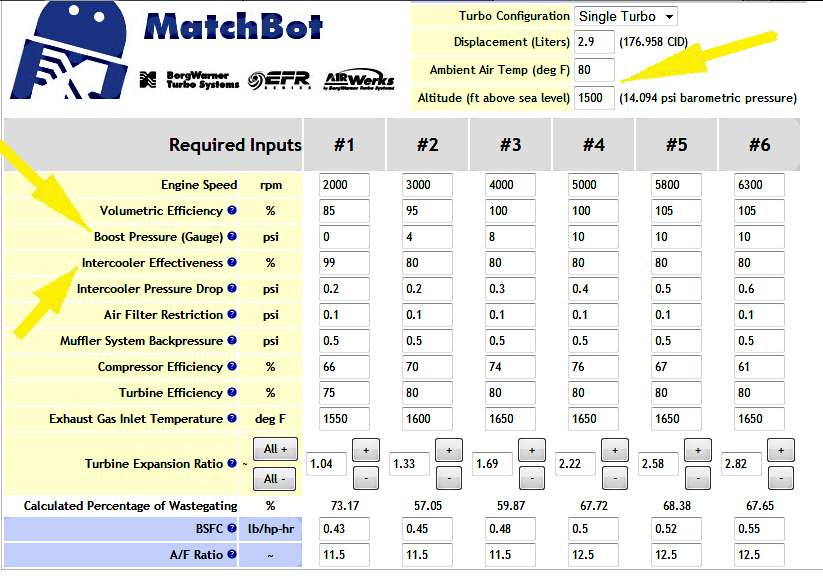
...........Return To Mine & Other Bonneville Car Construction Pages
==================================================================
.........--- GM Atlas 2900 Turbo Compressor Maps I ---
==================================================================
On this page you will find turbo compressor maps for turbos that I looked at for the GM Atlas 2.9 liter that I'm going to use in my lakester.
If you also have an Atlas 2900 some of these might be a possible turbo to use and some not. Please though, if you consider any of these you need to do "your" homework and don't make a decision based entirely on what you see below. You also need to really look at what you are trying to achieve, a good street turbo, a street/strip turbo or a pure race turbo. If you don't get greedy you will probably be happier in the long run. Kind of like picking the right cam that will be a pleasure to drive with.
To create these maps I used Borg Warner's MatchBot web-base program that you can find ( HERE ).

Above is the input screen from MatchBot and I left all of the data as you see above but changed the rpm/boost points to represent different levels of boost. You will see the boost levels on each map and the corresponding peak HP for those levels.
==================================================================
Turbos for the Atlas 2900 that I wouldn't recommend first:
I don't really think that the next two turbos are a good match for a 2900. I posted them to point out what you don't want in the way of a match. One is too large and the other on the small side for the 2900.
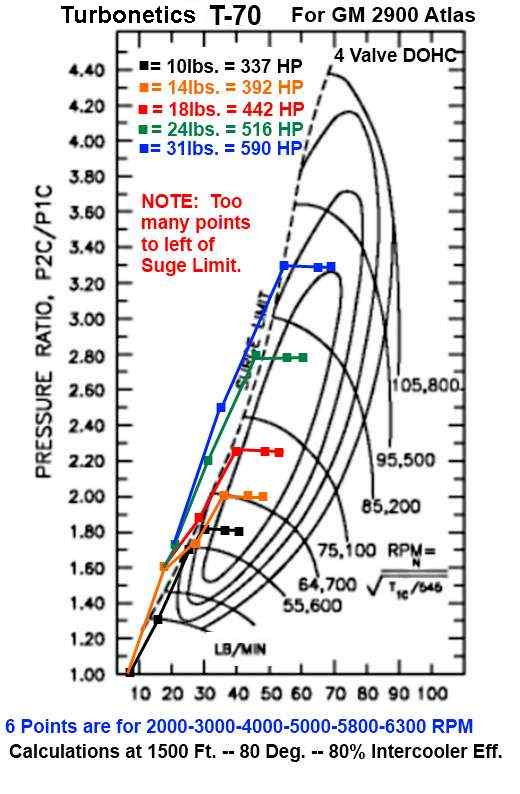
The T-70 above is not a bad turbo, but I don't think it is a good fit for the 2900 as it has too many of the calculated points over in the surge area to the left. So it is making more air than the 2900 can consume.
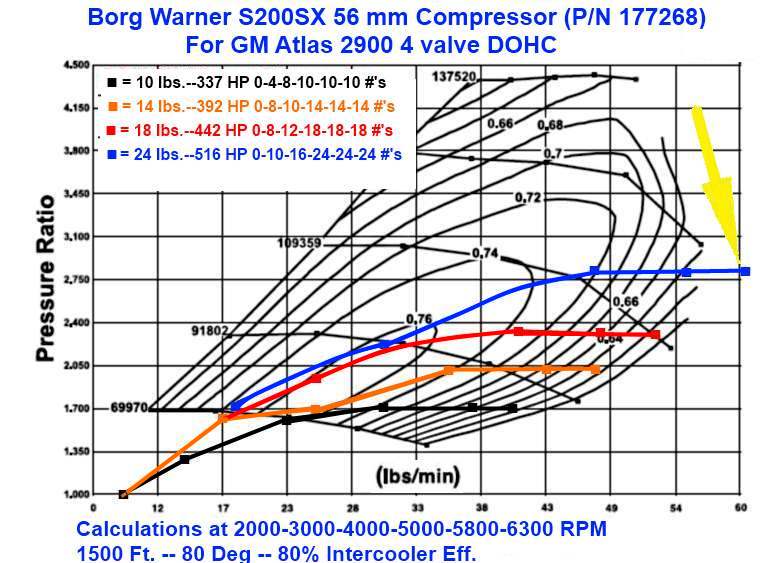
The Borg Warner S200SX ( P/N 177268) seems to present the opposite problem of the T-70. The calculated points are falling off into the compressors inefficiency zone on the right side and the compressor just can't keep up to the air needed at the 516 HP level (see arrow). The turbo would probably work at the lower HP areas but even there it is operating over in the area of inefficiency at the higher rpm points at the lower boost levels. Since other turbos are a better fit I'd pass up on this one.
NOTE: Borg Warner has a number of different S200SX, S300SX and S400SX turbos so don't assume that all in each category (200, 300 & 400) are the same. You really need to get the compressor map for the particular turbo you are interested in. That is the reason I've also noted the part number in each case. They also vary by quite a bit in price for each level (200, 300 & 400). I've tried to stay with the models that are under $800 in each case.
==================================================================
Possible Good Turbos for lower boost street levels that should spool well with the 2900:
The next 3 turbos were looked at for the Bonneville engine but just weren't up to the HP/air demands needed there. They did show a lot of promise though for a street 2900. They should spool very quickly and the second 2 be good for 500 HP plus numbers if your engine is built for that but let's start with a turbo from Turbonetics that might work up to the 400 range.
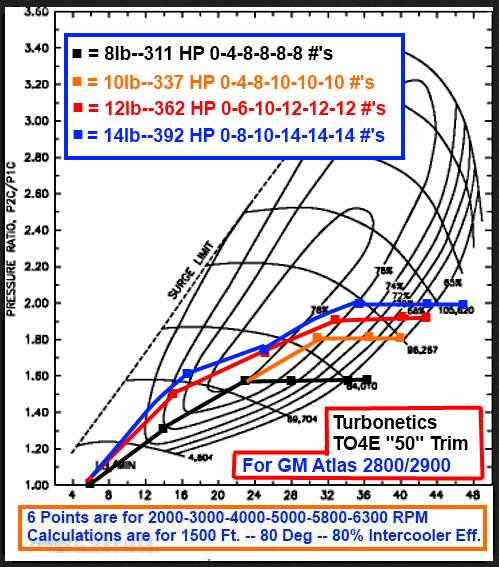
There is at least one of the above TO4E "50' Trim turbos out there right now running on a 2900 and the owner seems very pleased with the performance. Using MatchBot and the same inputs I've used on the other turbos it appears that the turbo might be running out of air up around the 6300 rpm red-line, but that is on paper. I hope to get some real world input to compare to this 'paper data'.
The next two turbos are larger turbos that will work with HP levels north of 400 HP and also work down in the 300+ HP range. Especially the second one, the Turbonetics 62-1, which just might be what I think is the best choice for a 2800/2900 drawing from the turbos on this page for street use with a little strip use. With the wide range of turbines for it you could fine tune it for your needs, but let's start with the Garrett first. Also now we are getting into the range of needing more than a stock motor and needing at a minimum probably better pistons.
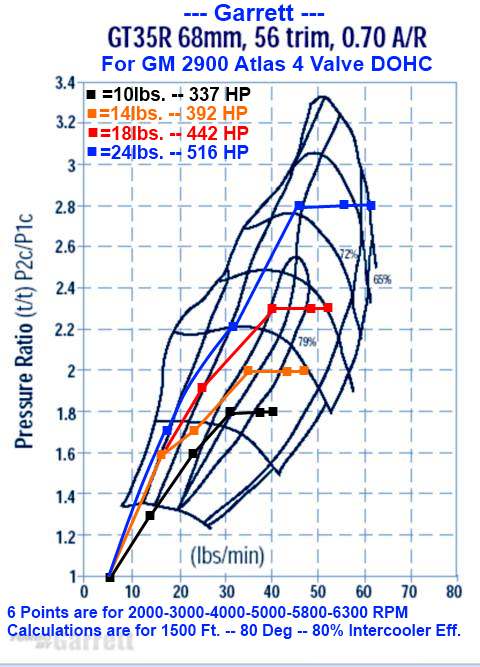
... The Garrett above looks very nice and I feel might be worth a looking at for a street 2900 as it is running in a very efficient area of the map up to about 500 HP.
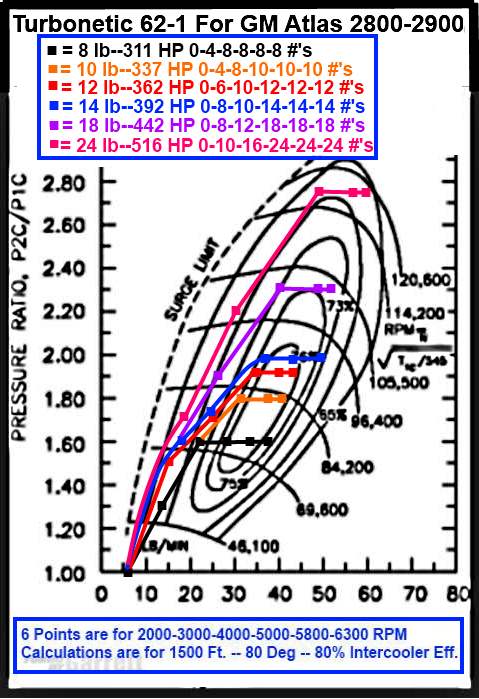
The Turbonetics 62-1 above is also a very interesting turbo as it looks very nice down low at 8 lbs. of boost and has the potential possibly of over 500 HP. It is offered with turbines in the .58 to 1.30 A/R size so picking one with the A/R to best suit your needs is a good possibility. The 10998 at Summit has a .68 A/R and the 10996 has a .81 A/R for instance. You can find the turbo for less than $800 in the plain journal models and around $1200 if you feel you need one with ceramic bearings. Turbonetics has a lot of options with these turbos and other ones in their line. The 62-1 turbo at 500+ HP is moving into the next category -- Strip/Strip, but this next one for sure is with close to 600 HP potential.
==================================================================
NOTE: Below you will see me reference Turbonetic's Hurricane Series turbos in a couple cases. This is a series of turbos that have smaller compressor housings with larger wheels in them and they have done this to package them better for people who are having problems room wise in their engine compartments. For instance the next turbo can be ordered as a T66 or a Hurricane model where the compressor wheel is in a 60 series housing vs. the T series housing. Putting the larger wheel in the smaller housing is going to lower the flow some. The maps below are with the compressor wheel in the larger housing and if you see "Hurricane" you will know that the flow will be somewhat less than the map shows. Turbonetics doesn't publish the maps for the Hurricane series but will tell you to use the maps for the compressors with the same wheel in the larger housing and you will be close.
Also almost all of the Hurricane Series turbos have a ported shroud that moves the surge line to the left that can help in running a larger compressor on a smaller engine. The Hurricane series will sacrifice some potential HP at the upper limit but will be more responsive on the street. So make a choice and call one of their techs before making a final decision.
==================================================================
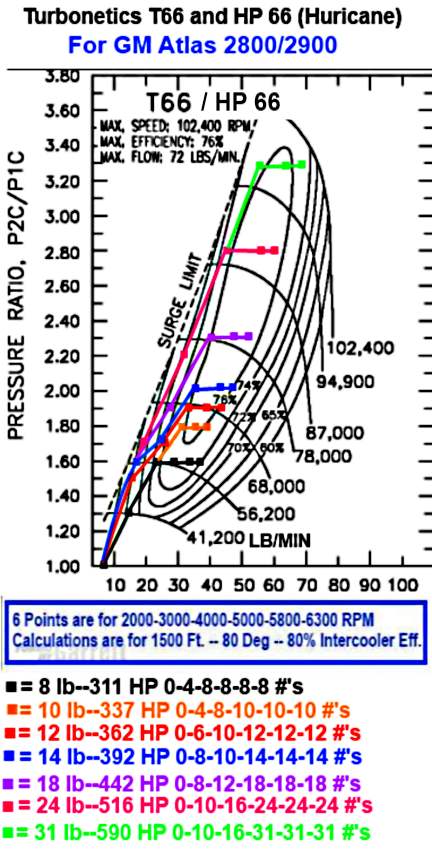
The T66 compressor above has a lot of potential and comes either as a Hurricane Series Turbo or not. The Hurricane series is more compact. The Non-Hurricane T66 flows better in a larger compressor housing with the same wheel. The Hurricane compressor has a ported shroud which helps to avoid surge and you can see above we are near the surge line to the left of the map. The map above does not show the extended surge line. You can also order the non-Hurricane T66 ported as an option. Also the Hurricanes come with either a .81 or .82 A/R turbine. Also all of the Hurricanes can be ordered with Ceramic Ball Bearings.
==================================================================
Possible Good Turbos for street/strip and pure race applications for the 2900:
The next 3 turbos are ones I looked at for the lakester for Bonneville and/or also to use in my pickup for some street and strip use. The second one I really like for the street/strip deal and the last is pure Bonneville use only unless you possibly mounted a different turbine on it and then it would be pretty much dedicated to the strip still.
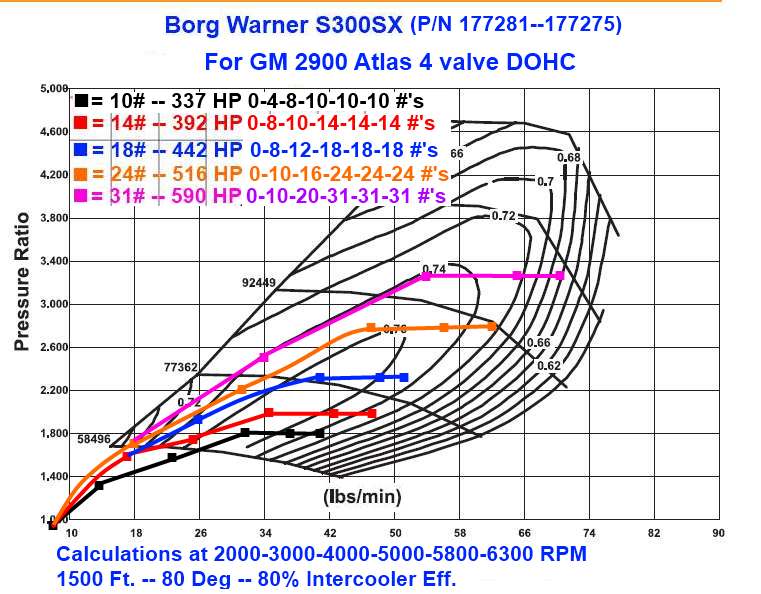
The S300SX model above (remember there are a number of 300's) looks pretty good for a street/strip car and would probably spool pretty decent with the .88 or .91 A/R depending on which one you bought (P/N's 177281--177275). If you were looking to get into the 500 HP range and the motor had good parts this might be a good choice but if you want more and the next one might be the one to go for.
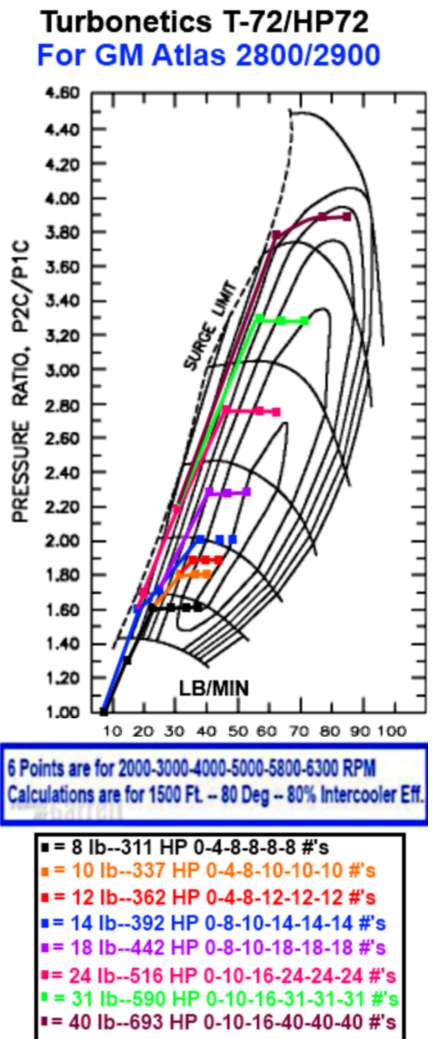
The Turbonetics T72 above and the Borg Warner K29, the next turbo, might be a toss-up for a turbo that would work on the street and be a serious turbo for the strip. I found the K29 first but might move the T72 ahead of it if I wanted a more responsive turbo for the street side. They are pretty much a match for potential HP but the K29 comes with a 1.0 A/R whereas you can get the T72 in the Hurricane Series with a .81 or .84 A/R turbine. Also the Hurricane series has a ported shroud compressor and that would help in preventing possible surge. You can also get the T72 as a non-Hurricane Series with a little larger housing that would flow a little more and could also order it also ported, but I don't see the need for more flow than what the Hurricane Series provides and they are a little smaller and package better. As always check with the tech guys at Turbonetics before making a final decision. As you can see above the 2800/2900 Atlas is an example of a turbo/engine match that gets the last bit of HP the turbo has to offer, in this case 693 HP of the 700 HP Turbonetics advertises for this turbo.
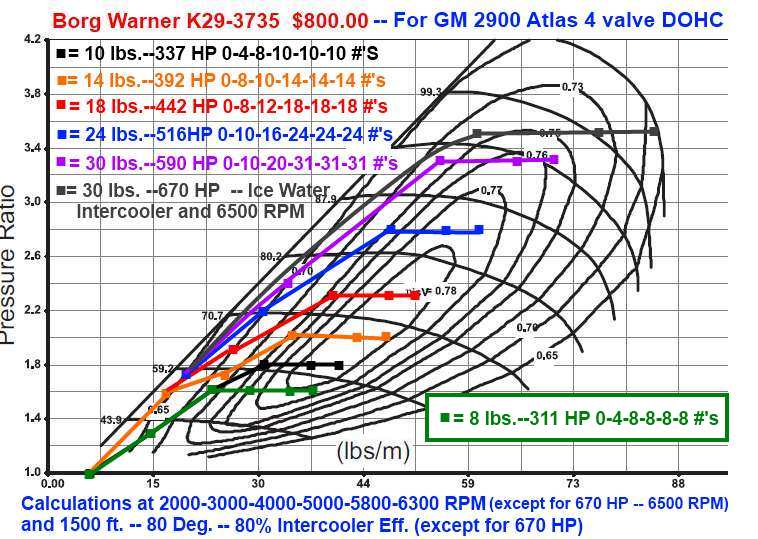
If I put a 2900 into my street rod pickup the turbo above might be at the top of the list if I didn't go for the T72 just above. The motor would have to have pistons, rods, and other mods but this could be a killer combination for something like drag week. Capable up to 600 HP and possibly near 700 HP and still looking very good down at 10 lbs. of boost this turbo looks like a nice combo except for the 1.0 A/R. You could mount a different turbine on it but that would probably hurt the output up top. Also beware that the turbine exducer is not what you normally see and you will have to fab up a manifold/exhaust pipe to work with it. This turbo would be happier with a higher stall converter to get it to spool well at the drag strip which would hurt it for street work.
Also this turbo is a twin scroll newer style Borg Warner turbo and splitting the exhaust input to it will help the spool. With the 4 cylinder you would have every other cylinder's exhaust in the firing order going into one side of the turbine input and the other 2 cylinder's exhaust going into the other side (a split manifold/header). This would require 2 wastegates but they could be smaller.
At the time I write this I might put this turbo on the race car (lakester) for the first year as I'll be running lower boost numbers with the near stock engine. Then I could move it to the pickup with a 2900 in it and move up to a larger turbo for the lakester when the engine is built with good parts.
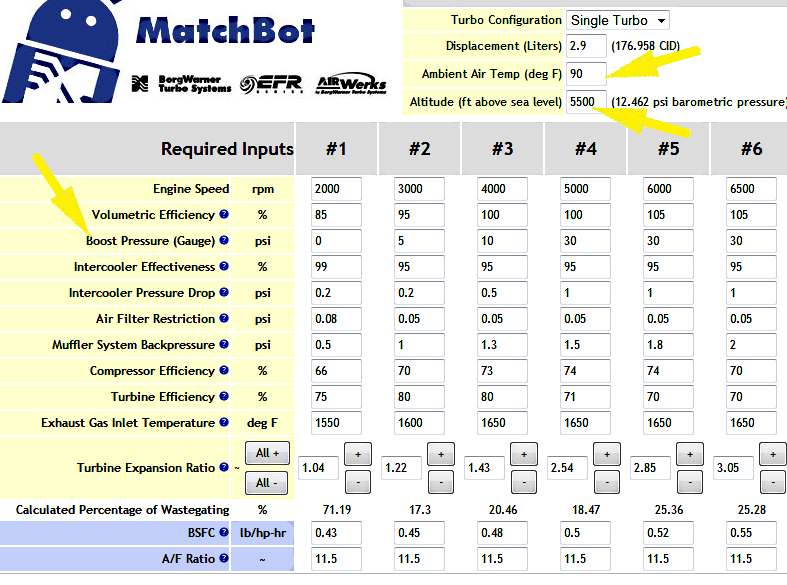
The next turbo that I'll probably run on the 2900 that is in the Lakester. Above is the input screen from MatchBot that I used. Note now the Intercooler Effectiveness is higher at 95% as I'm using a ice-water intercooler instead of an air to air. Also the 30 lbs. of boost at the last three rpm levels is for the final reading on the BW K29-3735 turbo above as I wanted to see how it would respond to the better inlet temperature cooling. It did with 670 HP with the better cooling vs. the 590 HP with the air to air and at 1 lb. less boost.
For the next map I also used the above inputs but changed the rpm/boost points to represent different levels of boost as shown on the map except for the 10 lb -- 337 HP data set that came from the MatchBot air to air intercooler inputs.
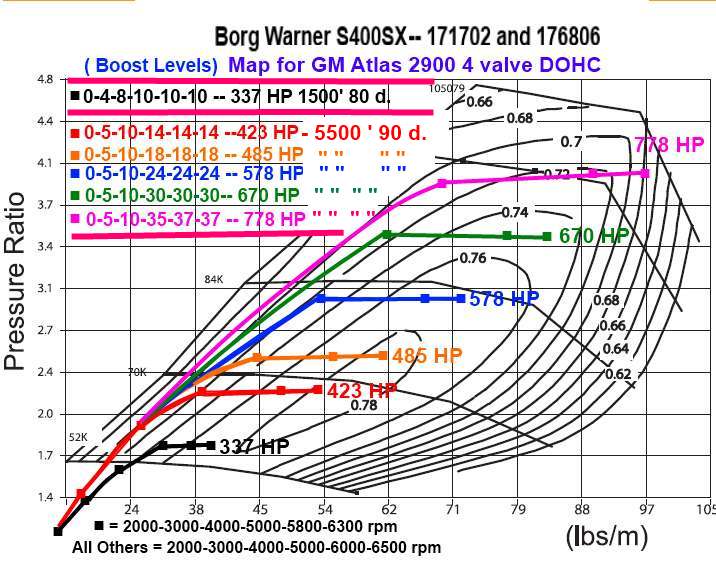
This S400SX Turbo (P/N 171702) looks like a really good turbo on the salt in the lakester. Possibly up to just short of 800 HP. Even though this turbo looks like it would work down at 10 lbs. of boost forget it for a street driven car as it has a 1.32 A/R and being so large would be slow to spool and doesn't really come on HP wise until you get past 4500 rpm. On the salt that is not a big negative. It is working in a very efficient part of the map at all boost levels staying above 70% for about all the points except for the very last point.
==================================================================
NOTE: Above is only a sample of turbos that might be a good choice for the Atlas 2900. There are many others that would also work, depending on how much you want to spend and what your goals are. Do your homework and take the time to learn and use a turbo calculator.
====================================================
...........Return To Mine & Other Bonneville Car Construction Pages